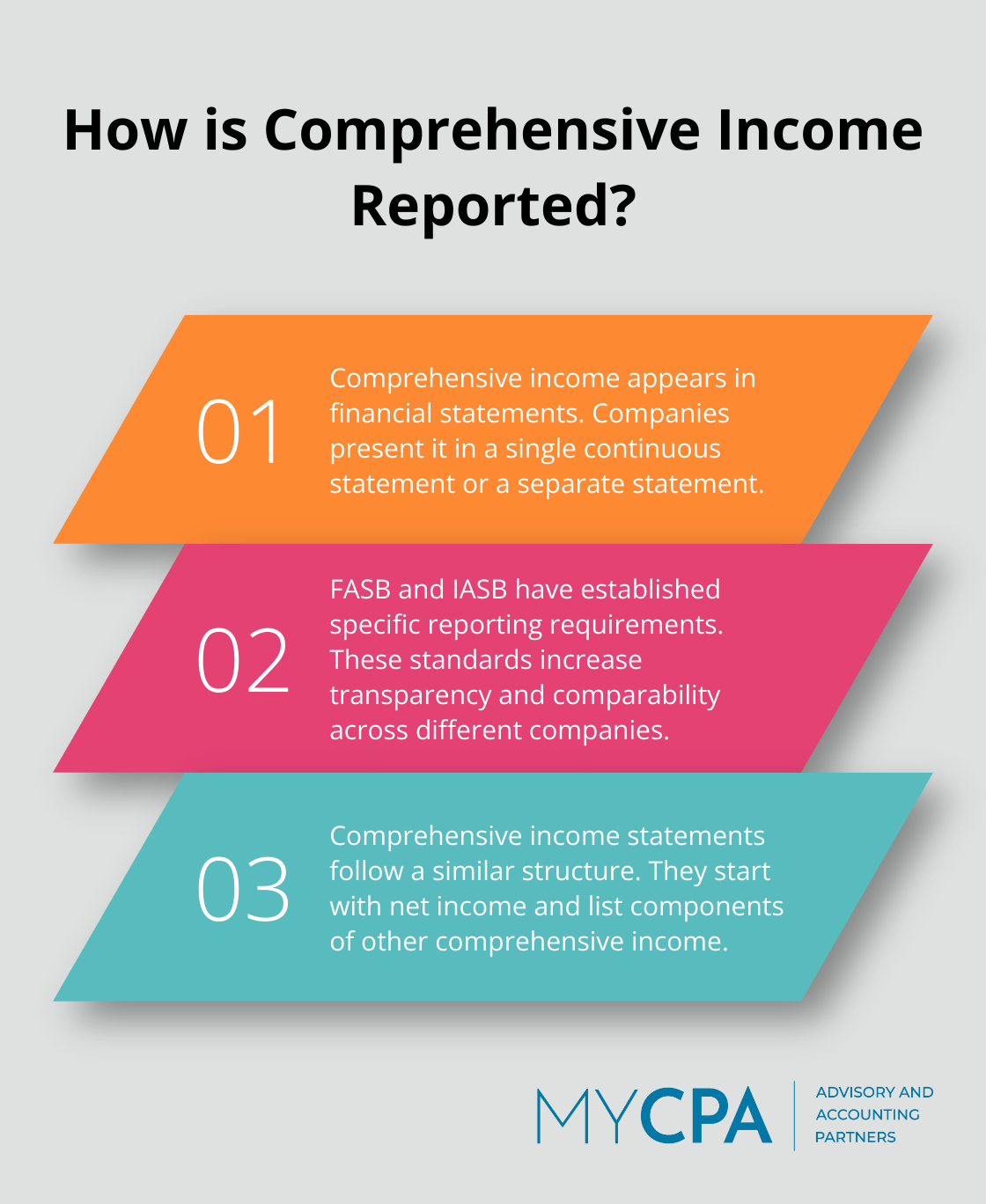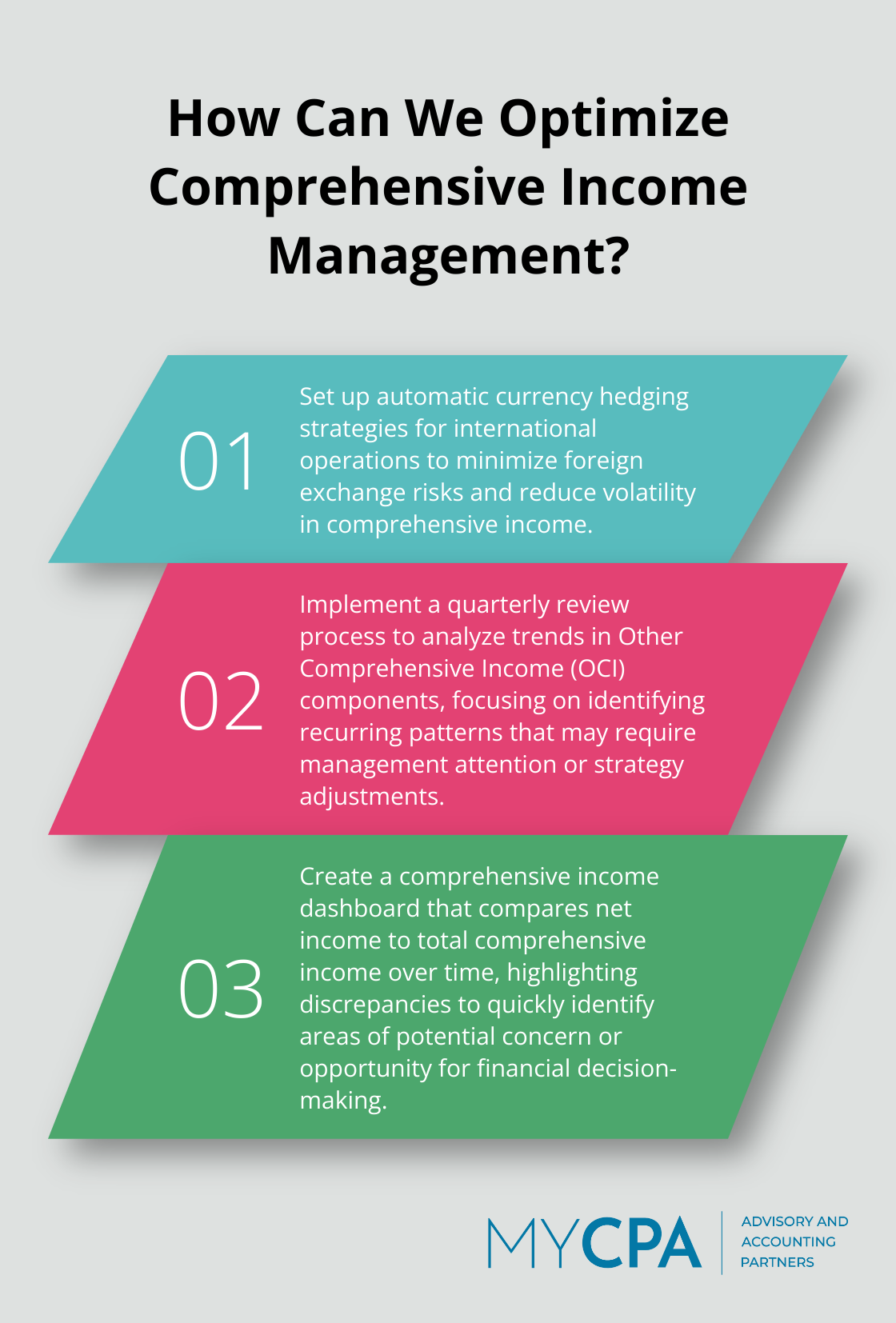
At My CPA Advisory and Accounting Partners, we often encounter questions about comprehensive income in accounting. This concept goes beyond traditional net income, encompassing a broader view of a company’s financial performance.
Understanding what comprehensive income is and its examples is essential for accurate financial reporting and analysis. In this post, we’ll explore the components of comprehensive income, its reporting requirements, and its impact on financial decision-making.
Comprehensive income provides a broader measure of a company’s financial performance than traditional net income. It includes both net income and other comprehensive income (OCI), offering a more complete picture of a company’s financial health.
Comprehensive income consists of two main parts:

OCI often results from external factors beyond a company’s control. For instance, a U.S. company with European operations might experience changes in asset values due to currency fluctuations. These changes won’t affect net income but will appear in comprehensive income.
OCI typically includes:
Understanding comprehensive income holds significance for businesses of all sizes. Here’s why:
Enhanced Performance Evaluation: It offers a more complete view of a company’s financial health, especially for businesses with significant international operations or investment portfolios.
Improved Risk Assessment: By including unrealized gains and losses, comprehensive income helps stakeholders assess potential future impacts on the company’s financial position.
Increased Transparency: Reporting comprehensive income separately from net income allows for greater clarity in financial statements, enabling investors to make more informed decisions.
When analyzing financial statements, it’s important to look beyond net income. The statement of comprehensive income provides a fuller picture. Analysts should pay attention to trends in OCI items over time. For example, consistently negative foreign currency adjustments might indicate a need for better currency risk management strategies.
For investors, comparing a company’s net income to its comprehensive income can reveal important insights. A significant discrepancy between the two might warrant further investigation into the company’s risk exposure and financial stability.
As we move forward, it’s important to understand how companies report comprehensive income and the specific requirements set by accounting standards bodies. This knowledge will further enhance our ability to interpret and utilize comprehensive income data effectively.
Comprehensive income appears in specific sections of a company’s financial statements. Companies typically present it in one of two ways:

For example, Apple Inc. uses a separate statement approach in its financial reports. This method allows investors to clearly distinguish between the company’s operational performance (reflected in net income) and the broader financial picture (shown in comprehensive income).
The Financial Accounting Standards Board (FASB) and the International Accounting Standards Board (IASB) have established specific requirements for comprehensive income reporting. According to these standards, a single statement must present the components of net income and total net income, the components of other comprehensive income and total other comprehensive income.
These standards increase transparency and comparability across different companies. A multinational corporation like Procter & Gamble must clearly show how currency translation adjustments affect its overall financial position, separate from its core business performance.
The format of comprehensive income statements can vary, but they generally follow a similar structure. They start with net income, then list out the components of other comprehensive income, such as:
Unrealized gains or losses on available-for-sale securities
Foreign currency translation adjustments
Changes in pension liabilities
General Electric’s statement of comprehensive income in its annual report clearly delineates these components, providing stakeholders with a detailed breakdown of factors influencing the company’s overall financial position beyond just operational performance.
When examining these statements, it’s important to identify recurring patterns in OCI items. If a company consistently reports large foreign currency translation losses, it might indicate a need for improved currency risk management strategies.
Companies like My CPA Advisory and Accounting Partners help clients navigate these reporting requirements, ensuring financial statements accurately reflect comprehensive income in compliance with current accounting standards. This approach not only satisfies regulatory requirements but also provides stakeholders with a clearer picture of a company’s overall financial health.
As we move forward, we’ll explore how comprehensive income impacts financial analysis and decision-making processes for investors and stakeholders.
Comprehensive income significantly affects company valuation. The Journal of Accounting Research found that firms with higher levels of other comprehensive income (OCI) often have higher price-to-book ratios. This indicates that investors value OCI information when assessing a company’s worth.

Consider a multinational corporation like Coca-Cola. Its comprehensive income statement might reveal substantial foreign currency translation adjustments due to global operations. These adjustments, while not affecting net income, can indicate potential future earnings or losses, influencing investor perceptions and the company’s market value.
The incorporation of comprehensive income into financial ratios provides a more holistic view of a company’s performance. The return on equity (ROE) ratio, which uses net income divided by shareholders’ equity, offers a perspective on a company’s profitability relative to shareholder equity.
For example, in 2020, Microsoft reported a net income of $44.3 billion and comprehensive income of $47.4 billion. Using comprehensive income in the ROE calculation results in a higher ratio, potentially indicating better overall performance than the traditional ROE might suggest.
Comprehensive income offers valuable insights into a company’s risk exposure and overall financial stability for investors and stakeholders. It highlights potential volatility in earnings that might not appear immediately apparent from net income alone.
Take a company like Boeing, which uses hedge accounting for its foreign currency exposures. The gains or losses on these hedges appear in OCI, providing investors with important information about the company’s risk management strategies and potential future impacts on earnings.
The analysis of comprehensive income components allows for a more nuanced risk assessment. For instance, unrealized gains or losses on available-for-sale securities (reported in OCI) can indicate the sensitivity of a company’s investment portfolio to market fluctuations. This information proves particularly valuable for financial institutions and companies with significant investment holdings.
Comprehensive income facilitates a more accurate evaluation of a company’s long-term performance. While net income focuses on short-term operational results, comprehensive income captures broader economic factors that may impact future performance. This expanded view (including items like pension plan adjustments and foreign currency effects) allows analysts to make more informed predictions about a company’s long-term financial trajectory.
Comprehensive income has become a vital concept in modern accounting practices. It provides a more complete view of a company’s financial performance by including both net income and other comprehensive income. This broader perspective proves especially valuable in today’s global economy, where factors like foreign currency fluctuations can significantly impact a company’s financial position.

The importance of comprehensive income in financial analysis extends beyond traditional profit and loss statements. It captures unrealized gains and losses that may have future implications for a company’s financial stability. As global markets become increasingly interconnected, the need for transparent and comprehensive financial reporting will only grow.
At My CPA Advisory and Accounting Partners, we help businesses navigate the complexities of comprehensive income reporting. Our team provides valuable insights for strategic financial management, ensuring accurate reporting and compliance with evolving standards. Understanding what comprehensive income is in accounting and its examples will remain essential for making sound business decisions in the future.








Privacy Policy | Terms & Conditions | Powered by Cajabra